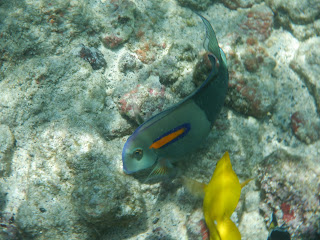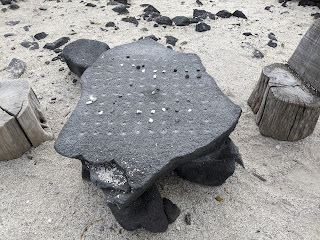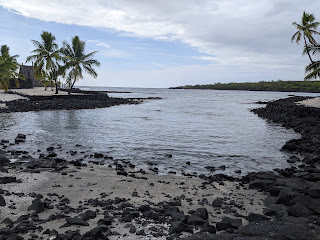Though Steven and I are not bodyboarders, it was fun stopping at the tiny Honi Beach after learning that the first Boogie Board, the brand name version of the most popular bodyboard, was tested by Tom Morey way back in 1973. Plenty of sharp rocks didn't make it an inviting place to swim.
After the very long day the day before exploring all of the southern parts of the Island of Hawaii, we were more than ready to plop ourselves down at Magic Sands Beach for some R&R!
It wasn't quite as quiet as we'd have liked because of the regular announcements from the lifeguards imploring people not to enter the water from the center of the beach because crashing waves were hiding partially submerged rocks. One of the lifeguards "joked" that the rocks were part of the island and don't move and they can cause serious injury if people come too close to them!
The announcements were necessary so not a problem if they led to more awareness and public safety. But the lifeguards blasting their music on loudspeakers was definitely an unwelcome first for us at any beach.
We didn't stay as long as we might have liked because of fraying tempers among some of the beachgoers due to the limited space on the beach. We've been to many a beach in many a place and it wasn't until we visited several beaches throughout Hawaii that we encountered really negative interactions between people on the beach.
Even though all beaches in the state by law are public, some people seemed to think they "owned" or were entitled to a certain amount of sand space and got unnerved when others, though not us, got in their space. This wasn't the first time we ended up just leaving a beach as it was no longer enjoyable to hear the dissension.
As Kahalu'u had the reputation for being the island's most easy-to-reach snorkeling spot, we wanted to see what it was like. According to legend, the ancient breakwater that had been built by the Menehune or "little people" protected the bay and made it pleasantly calm.
The Kahalu'u beach was extremely narrow so most people opted to plop down behind a three-foot wall on the salt-and-pepper expanse that was comprised of lava and coral sand. We had no view of the water there but there was certainly plenty of space to spread out so didn't hear people complaining about others encroaching on their space, thank goodness.
Staff at Kahalu'u Bay had identified over 100 different species of fish in the bay's diverse and abundant coral reef system with each one playing an important role in ecosystem health. About a quarter of the fish, eels, and urchins in the bay were endemic to Hawaii, meaning they were found nowhere else in the world.
Snorkeling at Kahalu'u was pretty decent but the dropoff was quite steep from the rocky shore into the bay.
Yellow tangs were among the most common fish we spotted while snorkeling in all the Hawaiian islands.
Sailfin tangs were less common.
The orangeband surgeonfish was another common variety.
I liked the pretty orange stripes on the pale blue threadfin butterflyfish.
The iridescent parrotfish was another favorite.
What a beautiful place to learn to surf as these people were doing!

Just steps from the beach was the very tiny St. Peter's by the Sea Catholic Church. Also called the Little Blue Church, it was built in the 1880s and was moved from another beach in 1912.
As a Catholic myself, I found it very hard to comprehend why church elders had chosen this specific location on top of a former heiau or native temple to construct the church.
From Kahalu'u, we headed to the very melodramatic-sounding End of the World by Keauhou where a lava plain of unforgiving jagged rocks dropped steeply into the ocean.
We made sure to stay clear of the cliffs after seeing waves crash like thunderheads on the rocks.
One of the major religious sites for native Hawaiians is the hard-to-reach Kealakekua Bay accessible via a steep and winding 4.5-mile-long road. At the bottom of the road was Hikiau Heiau, a broad stone platform temple dedicated to the war god Ku.
In the 1700s, the imposing Hikiau Heiau was one of the most important religious structures on the island of Hawaii. Its location offered a commanding view of Kealakekua Bay and the surrounding lands. Ho'okupu or offerings such as pigs, dogs, fish, and vegetables were placed on a wooden platform.
The function of the temple changed throughout the year. During the Makahiki season from November to February, the heiau was dedicated to the god Lono and ceremonies were conducted to insure rain and the fertility of the crops. When Kamehameha II broke the Hawaiian land system known as kapu in 1819, that resulted in the traditional religious system being abolished and the heiau dismantled. The rock platform was still a reminder of its religious and cultural importance and therefore to be treated with respect by all.
The bay's incredible natural beauty is the big draw on the south coast. As both a state park and a marine life conservancy, it was famous for its abundant variety of sea life, including spinner dolphins.
The bay also was of supreme historical importance as it marked the spot where Captain James Cook and, by extension, the outside world first set foot in the Hawaiian archipelago which forever changed the destiny of the islands and their people. Visible across the bay was a monument to Cook where he was thought to have landed.
Near the bay was Pu'uhonua o Honaunau National Historical Park, an ancient Hawaiian sanctuary that translated to"place of refuge at Honaunau." A little history about the kapu system that regulated every waking moment of ancient Hawaiians is needed to understand the importance of Pu'uhonua. Under kapu, a commoner couldn't look at or walk in the footsteps of ali'i or priests. Women weren't allowed to cook for or eat with men. Hunting, fishing, or gathering wood were each restricted to certain seasons.
According to the Hawaiian belief system, those that violated kapu were hunted down and killed because they had infuriated the gods who were responsible for tidal waves, volcanic eruptions, earthquakes, and famine which could be devastating to all. The one loophole to evade death for commoners who broke kapu was to attempt to reach the sacred ground of a pu'uhonua which also provided sanctuary for defeated warriors or those unable to fight.
Getting to the pu'uhonua or sanctuary was supremely difficult as it involved eluding pursuers on foot, reaching the coast, swimming through the open ocean, and braving sharp lava, strong currents, powerful waves, and sharks to reach safety. If kapu breakers reached the pu'uhonua, priests performed ceremonies of absolution to appease the gods so they could return to start anew.
The pu'uhonua at Honaunau was used for several centuries until King Kamehameha II and Queen Ka'ahumanu ate together in public in 1819, thereby overthrowing the ancient kapu system once and for all.
The historical park had an excellent self-guiding tour through the Royal Grounds and the pu'uhonua that we took advantage of. The former was where the ali'i or priests held gatherings, hosted ceremonies, and negotiated war and peace.
Konane was a Hawaiian strategy game played with black and white stones on a rock playing surface played by ali'i and commoners but not together.
This kanoa or bowls carved into rock might have been used for dying bark cloth, tanning fishing nets, or pounding roots to make a ceremonial drink.
In the kapu system, only ali'i or priests could land in this protected cove.
Just beyond the cove was The Great Wall which defined the sacred space of the pu'uhonua. Constructed about 1550 without mortar it was up to 12-feet tall, 18-feet wide, and almost 1,000-feet long, so indeed great! Inside the wall that separated the Royal Grounds from the pu'uhonua were two older heiau platforms.
The Hale o Keawe was a heiau or royal mausoleum that contained the bones of 23 ali'i or high priests. It is still revered by Hawaiians who sometimes leave offerings.
The wooden images represented Hawaiian gods to alert everyone of the great mana or the spiritual energy of power and strength.
I had difficulty imagining those seeking refuge scrambling over the lava rocks to find safety in the pu'uhonua.
According to legends, Kamehameha's favorite wife swam to the pu'uhonua after they quarreled and hid under this stone before her barking dog gave away her presence. The two fortunately reconciled.
Small depressions were carved into flat lava rocks to play konane the game we saw earlier. However, it was more than just a game as skills mastered in the game could be applied to battle.
Long ago, a heiau that may been the refuge's first was built here. Centuries of ocean waves have raged the site so only remnants were visible of some of the oldest structures in the park.
As we walked closer to the Great Wall, it was stupefying to see how the stones fit together so perfectly with no mortar - imagine one gigantic puzzle!
In ancient times, this canoe house would have been made with ohi'a wood tied with cord and thatched with pili grass.
Steven and I really enjoyed walking through the large historical park but found the lack of signage showing the demarcation between the royal grounds and pu'uhonua frustrating as that seemed to be crucial to understanding the kapu system.
With all the island's rain came stunning roadside flowers as we drove to another painted church.
Overlooking beautiful and historic Kealakekua Bay in the famous Kona coffee growing region, St. Benedict’s Painted Church was another fascinating place to visit on the Big Island of Hawaii. It was erected in 1899 by Father John Velghe of Belgium.
The vaulted nave was modeled by Velghe on the Gothic cathedral in Burgos, Spain.
Without any professional training and using house paint on ordinary wood, he adorned the church with his paintings from the Bible and the lives of the saints. These were very important teaching tools in a time when many people couldn’t read and write.
Along the same road was the Donkey Mill Art Center which was created in 2002 from a coffee mill that had been built in 1953 with a donkey on its roof. The donkey was of more interest to me than the gallery inside!
Next post: Discovering Kohala and Waimea in northern Hawaii.
Posted on May 31st, 2022, from the idyllic community of Chester, Nova Scotia where we've come to reconnect with old friends.










































































The underwater photos you captured of the magnificent Hawaiian tropical fish are stunning.
ReplyDeleteI hope your current travels in Atlantic Canada afford you some other great "Kodak" moments. xo Lina
Ahh cc that, Lina, for the sweet comment about the photos.
ReplyDeleteHaving a wonderful time reconnectiing with dear friends in Chester and Luneburg which I hope to post about before too much time passes.